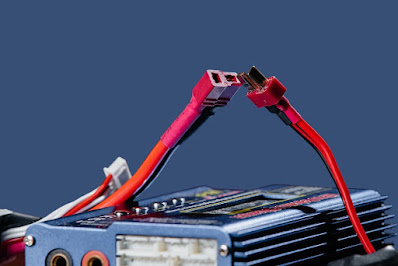Lithium polymer (Li-Po) batteries are a popular battery choice because of their unbeatable attractive attributes. These include high energy density, low weight, and higher discharge rates. LiPo batteries have transformed every facet of radio-controlled (RC) batteries. Although it has many advantages, we require extreme caution when charging this battery.
Li-Po batteries offer a host of electrical benefits
I commonly used Li-Po batteries come in a variety of sizes and shapes and in RC cars, boats and aircraft. Compared to other types of batteries, LiPo holds a higher charge and is also lighter. Since its introduction and continuous improvement, it has improved the performance of cars, boats, airplanes, helicopters and other RC vehicles. In addition, new types of vehicles such as multi-rotors now use LiPo batteries.
Lithium-polymer batteries offer many electrical advantages. However, this is not without cost. This battery has a higher risk of damage if not handled properly. That’s why users should take a few precautions to get the most out of LiPo batteries.
Capacity and voltage
When handled properly, LiPo batteries can offer high performance compared to other battery types. In terms of proper handling and use, there are two fundamental aspects of the battery that one must understand. These are the capacity and voltage of the battery. For example, a battery labeled “4S-2200”, which shows the capacity and voltage of the LiPo battery.
Here, the “4S” means there are four cells in series. Since each cell has a voltage of 3.7 volts (or 4.2 volts when fully charged), the battery has a total voltage of 14.8 volts or 16.8 volts. The second number refers to the capacity of the battery in milliampere hours (mAh). A fully charged 2200 mAh battery can deliver 2200 milliamperes of current for one hour before being completely discharged.
The number of cells does not affect the capacity value of a LiPo battery in a series. The capacity value provides you with valuable information so that you can estimate how long the battery can provide you with useful power. However this information only allows an approximate comparison between different batteries.
Discharge rate
Another important aspect of a LiPo battery is the discharge rate. This is an important factor that allows the user to better determine the applications for which the battery can be used. The discharge rate is the value that allows users to determine how many amps the battery can continuously deliver without suffering damage.
Many RC applications require high amperage, making knowing a battery’s discharge rate crucial to a vehicle’s overall performance. LiPo batteries are at risk of catching fire if not properly charged. Fire departments are always eager to provide warnings and precautions for safe charging.
Charger and operator
There has never been a case where a LiPo battery caught fire while in storage. Fire accidents involving LiPo batteries often occur while the battery is being charged or discharged. Most battery problems occur during charging, and the fault usually lies with the charger or the person using it. This doesn’t always happen, but these are the common factors in most LiPo battery fires.
There are lessons to be learned from these incidents. First, users should invest in an excellent quality charger to prevent it from causing a fire. Second, the charger operator must learn how to operate the charger properly. An excellent choice of LiPo battery charger is one with built-in controls. This type of battery charger allows the user to set it up properly.
These chargers can charge not only LiPo batteries but other types of batteries as well. Although they have useful safeguards, it is ultimately the responsibility of the battery user to ensure that everything is in order and correct. The user must ensure that the charger is appropriate for the number of cells in the battery, that the charge rate is within the limits of the battery, etc.
Charging and Discharging Guidelines
Manufacturers often provide guidelines and warnings for charging and discharging LiPo batteries. We should always follow battery charging and discharging guidelines in common sense. To avoid fires and other accidents, safety should always be a priority. One of the most important reminders is to visually inspect the battery before charging.
The user or operator should look for any signs of damage, such as damaged connectors, frayed wires, swelling, and other irregularities. If it damaged the battery beyond repair, it should be discarded. Charging the battery may cause it to explode and catch fire. Charging the battery with chargers not specifically designed for this type of battery is also not a good idea.
Users should always use only a balanced lithium charger. They should also carefully follow the instructions for using the battery and charger. We should always use common sense and safety precautions when charging LiPo batteries. Leaving batteries unattended while they are charging or discharging is not ideal, as problems can occur during the process.
The user must be there to disconnect the battery if a problem arises quickly. We should do the charging and discharging process on a fireproof surface in an open area. Charging batteries near flammable material is a big no-no. If there is no suitable space for charging, a safety charging bag for LiPo batteries can be used. Batteries should be at room temperature before charging/discharging.
Check Our Recommendation!
EZ Battery Reconditioning is a downloadable e-book that contains informative resources on how to recondition several types of batteries. The primary purpose of this product is to help you extend the life of your electronic product batteries to save hundreds of dollars per year.
Click https://deliverit.blogspot.com/p/ez-battery-reconditioning.html for more review details.
These are just a few of the guidelines and warnings that every LiPo battery user should keep in mind. Using common sense and being aware of safety precautions will make it easier to prevent batteries from catching fire or being damaged. Lithium polymer batteries have many advantages in various applications. They are excellent batteries, but to get the most out of them, it is essential to use them safely.





